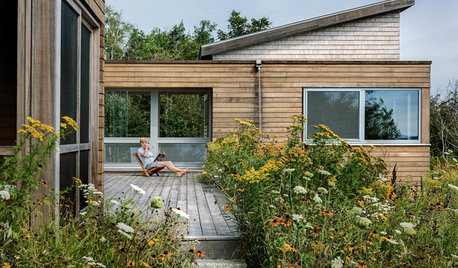Surgery on Nymph
java_j
15 years ago
Related Stories

GARDENING GUIDES3 Ways to Revel in Summer Garden Sweetness
Patiently observe what works and doesn’t work in your landscape
Full StoryMore Discussions
I would like to share some pictures of my surgical attempts to rescue a bulb.
After blooming, this bulb did not do well when I moved it outside. It got too wet. I noticed the problem before the bulb looked too bad, but all I did was repot it in drier soil. After about two weeks it didn't look any better.
I decided to take a closer look. This is what I found after removing the dirt and the obviously soft parts.
{{gwi:404358}}
I cleaned it up as much as possible. I noticed what looked like a rotting area coming from inside the bulb. The next picture shows the area of concern, marked by a red arrow.
{{gwi:404359}}
Not wanting to leave something rotting, I cut into the bulb to remove it. I ended up removing a wedge.
{{gwi:404360}}
Here is the entire bulb after all the surgery:
{{gwi:404361}}
As you can see, the roots look rather well. I think the damage was confined to the bulb. The big question is what to do next.
I am thinking of dusting it with bulb dust, which contains sulfur and bone meal, and then planting it in the soil I use for all my Amaryllis. It is sold as soil for Orchids and other bulbs.
I already did something drastic by giving the bulb a modified hot-water treatment and a bleach treatment. I hope I have not killed it.
Currently, the bulb is drying. I'll probably plant it in something tomorrow. I am open to any suggestions you may have.
One last photo. One of the outer bulb scales was only partially removed. The arrow in the next picture shows the partial scale. Any thoughts on whether it would be better to remove the scale completely or leave it as it is? It would probably get covered up by any soil.
{{gwi:404362}}

jodik_gw
java_jOriginal Author
Related Professionals
Beavercreek Landscape Architects & Landscape Designers · La Marque Landscape Architects & Landscape Designers · Tempe Landscape Contractors · Arden-Arcade Landscape Contractors · Doctor Phillips Landscape Contractors · Elmhurst Landscape Contractors · Eustis Landscape Contractors · Federal Way Landscape Contractors · Lake Worth Landscape Contractors · Selden Landscape Contractors · Twin Falls Landscape Contractors · Woodbury Landscape Contractors · Winter Gardens Landscape Contractors · West Palm Beach Swimming Pool Builders · Rocky Point Swimming Pool Buildersjodik_gw
java_jOriginal Author
jodik_gw
elizabeth_jb